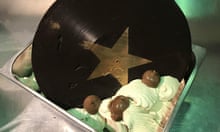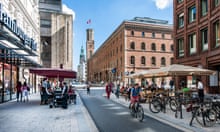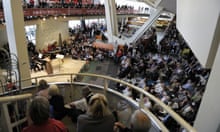On my way into Nuremberg, I read an article about modern art in which a theatre production is called a “Nuremberg rally of artistic desecration”. How, I wonder, can a city deal with becoming a byword for slavishly marching to the wrong beat? That was before the war, I remind myself, almost beyond living memory.
The Guardian’s product and service reviews are independent and are in no way influenced by any advertiser or commercial initiative. We will earn a commission from the retailer if you buy something through an affiliate link. Learn more.
That first evening I head into the medieval city from the station and find I’ve chanced upon a music festival: the streets are packed with buskers – everything from a young lad sawing uncertainly through a violin concerto, to slick rock bands selling CDs. The crowd is mainly German and they have packed every bar and restaurant to the rafters. It feels like the entire city is pulsing with excitement, determined to extract every ounce of pleasure from a fine summer evening.

I eat diminutive Nuremberg sausages – a local speciality – and drink local wheat beer. I watch an oompah band, then a Willie Nelson soundalike. They all get massive crowds and ovations. Everyone appears to be drinking but no one is drunk. They like their beer in Nuremberg, and so do I. A type called rotbier – red beer – is particularly tasty.
Next day I have a guide, Anne-Marie, and we visit the castle, Schöner Brunnen fountain, public sculptures and other significant spots. It’s a lovely city to stroll around: full of quaint pedestrian streets, bridges, cafes and bars. But the entire medieval ambience is a reconstruction: in the later years of the second world war, the city was pulverised by the RAF in a series of controversial missions that killed around 6,000 civilians and more than 500 airmen. Going to Nuremberg and not mentioning the war is, it turns out, like going to Cairo and not mentioning the pyramids.

Over subsequent years its proud citizens rebuilt it and to be honest it does look like a highly accomplished fake of an old master – a Dürer perhaps, as this was his home town and his house actually survived the bombing.
What is not fake is the art itself: the city has a treasure trove of works, such as stonemason Adam Krafft’s 15th-century tabernacle in St Lorenz church, a soaring masterpiece 18.7 metres high. Such pieces survived the war because they were either clad in concrete or moved into beer cellars. We explore the “art bunker” created in ancient cellars beneath the castle then head for the superb Germanisches Nationalmuseum. The collection here includes several Dürers, a Rembrandt and, among other things, a 2,500-year-old conical golden ceremonial hat.

I ask Anne-Marie about the days after the fall of the Berlin Wall and she recalls how the city, just over 100km from the border, was inundated with Trabant cars full of goggle-eyed DDR residents buying bananas and oranges.
“That made us laugh,” she said. “But it was a wonderful time. We welcomed them. There was a sense of community. It started change that climaxed at the 2006 World Cup. Then I felt proud to be German for the first time, proud of the flag.”
In this comment, I realise, is something hugely important: recent events that finally overcame an awkward past.

It is, however, time for me to tackle the issue. Next day, I head to the Nazi Documentation Centre, built inside the unfinished shell of Albert Speer’s Kongresshalle. There four other such centres around Germany – I highly recommend the one in Munich – that detail the role of local people and places in the rise of the Nazis.
The museum shows the locals no mercy, telling how Hitler played on all their envy, naivety and prejudice, then marched them around, whipping up hopes and dreams. A tour of the galleries finishes with a film of prosecutor Robert H Jackson’s opening address at the Nuremberg trials, one of the greatest speeches ever delivered. “The privilege of opening the first trial in history for crimes against the peace of the world imposes a grave responsibility …”

The museum was agreed on in 1994 and opened in 2001. Perhaps unification and the passage of sufficient time were necessary before such a self-laceratingly honest museum could be built. I walk out into the park behind the centre, where the vast rallies of the 1930s were held. In the Zeppelin airfield, where tourists now take selfies, Hitler used to launch furious tirades, rousing 180,000 spectators to a frenzy. This does not feel like a carefully curated site. It’s a mess. The steps are littered with broken glass and dandelions; some of the stands are disappearing under weeds. It feels edgy and awkward, like a vast embarrassment no one knows what to do with.
Later, back in town, I enjoy another happy evening in the reconstructed medieval streets. Nuremberg is built above four levels of sandstone caves – I take a tour run from Altstadthof brewery and end up in conversation with Rainer Engel, the owner. He shows me his new distillery, producing German whisky, and then the store where you can set aside your own wooden cask for posterity. The owners assemble annually to check how things are progressing. I don’t think posterity is going to get much of a look-in actually, as it is a very good whisky.

It’s time for me to leave and I reflect that Nuremberg has achieved what few would have thought possible: it has transcended a tortured past and rebuilt a better version of itself, one that should be seen. And for me, the war is definitely over: I’m finished with Nazi sites. Those Documentation Centres have worked for me too.








Comments (…)
Sign in or create your Guardian account to join the discussion